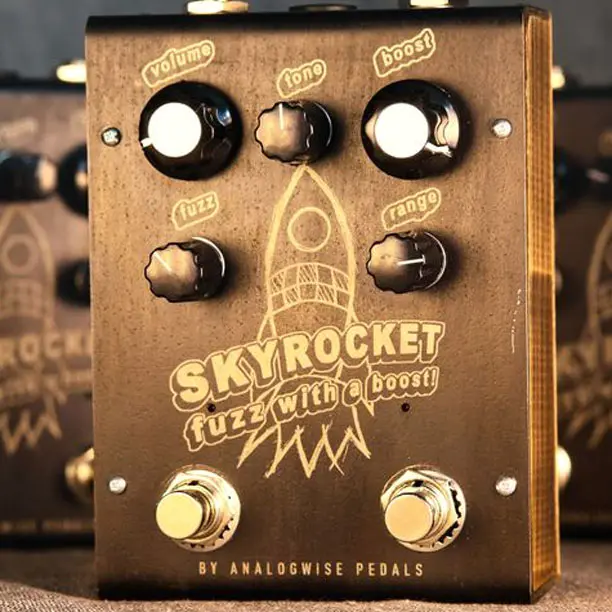
The Analogwise Pedals SkyRocket is a Germanium fuzz pedal with an additional boost circuit built into it, and it’s entirely made of reclaimed wood.
Each channel (boost and fuzz) has its own footswitch, which means that the pedals can also be used as a simple boost, boost-less fuzz, or fuzz + boost, for a total of three possible tonal combinations.
The boost circuit is placed before the fuzz and it’s controlled by the two knobs on the left: the Boost control sets the amount of volume, while the Range knob adds a touch of high-end to your original signal when it’s turned all the way counter-clockwise,.increasingly boosting the bass frequencies as you move it clockwise.
The fuzz, the result of two amplifying stages connected in series, each built around a vintage, NOS germanium transistor, sports controls for Fuzz, Volume and Tone.
The circuit has some quirks, as explained by the builder in this paragraph:
Depending on how you set your “fuzz” control, the “boost” control will act differently. Turned all the way counter-clockwise, it will mute the signal altogether. I could have restricted that, but decided that if you pay for the whole knob range, you should be able to use the whole knob range. So, your “boost” control can actually be used to… de-boost the signal. If you like your fuzz settings as they are and need to shave some gain off for a moment.
Here’s the first video of it.
Analogwise Pedals SkyRocket, Builder’s Notes
You’re looking at a germanium fuzz pedal, with an additional boost circuit built into it. You can switch the boost on with a separate footswitch to either push the fuzz even further, or just use it as a standalone clean(ish) boost, depending on the needs of the moment.
Here it is in a nutshell:
built with NOS germanium transistors;
true bypass – won’t suck tone when turned off;
goes from clean boost, through edge of breakup, to full-on fuzzy glouriousness;
powered with a standard 9V PSU
Need more details? Here you go.“Skyrocket” started as a… joke! Nagging online about how a selling platform shaved a scandalous amount off each pedal I sold, I ended up joking I’d put a “Pocket Rocket” circuit in a bigger box, call it a “Skyrocket” and start charging triple. Having a bad sense of humour and access to rapid prototyping tech can be a risky combination, and, well… here we are.
“Skyrocket” can be in fact considered a “bigger brother” to Pocket Rocket – a tiny fuzz with huge sound you can find among my other listings. The name and the artwork are no coincidences. What I did here is I took a Pocket Rocket circuit, made it run a bit hotter and warmer (“fattier” seems in fact a better term), put a switchable booster in front of it, and lo, behold, a Skyrocket fuzz was born.
The fuzz section is made with two amplifying stages connected in series – each built around a vintage, NOS germanium transistor for that fuzzy goodness. You can control its gain with the “fuzz” knob. It goes from almost clean to really fuzzy. The other two controls in the fuzz section allow you to set your output volume and tone.
The boost section is a separate circuit, sporting another NOS germanium transistor as its heart. Circuit-wise, it’s placed before the fuzz circuit and in series with it. It’s got a “boost” control that you’ll use to set the amount of boost and a “range” control. That last one does two things at the same time. Turning it all the way counter-clockwise will retain your original tone and add a tiny little bit of treble to it. Just a tiny sparkle. Turning it clockwise will result in more and more bass being boosted, and – as a consequence – more signal hitting the next stage.You can use both stages at the same time, you can use just the fuzz stage or just the boost stage. Do note, however, that with only the boost stage active, your tone and volume controls will be bypassed. The only controls active will be the two in the boost section.
Depending on how you set your “fuzz” control, the “boost” control will act differently. Turned all the way counter-clockwise, it will mute the signal altogether. I could have restricted that, but decided that if you pay for the whole knob range, you should be able to use the whole knob range. So, your “boost” control can actually be used to… de-boost the signal. If you like your fuzz settings as they are and need to shave some gain off for a moment. Cool, right?
The pedal is hand-made top to bottom. The top plate is made out of carbon steel, turned black by the process called “rust bluing”. A fascinating process in its own right. In short: cowboy era technology! The black layer is quite resilient to scratches, but you can treat it with a wipe of a slightly oily rag from time to time. This will restore the depth of the black finish. Avoid cleaning it with rough chemicals, acidic cleaners (vinegar is a no-no) or water baths. You know, baths, electric equipment, bad.
The sides are made out of solid wood – and not just any store-bought lumber, but dumpster rescuees. Instead of allowing them to rot in landfill, I cut them in pieces and made pedal enclosures. My two cents in the “saving the planet” dispute. That means there might be some dings or even holes in your pedal! That doesn’t mean you received a beat-up unit somebody else had abandoned. That’s not a bug, that’s a feature! The sides will quite enjoy some oil or wax on them from time to time, too! Will restore that slight shimmer.






















